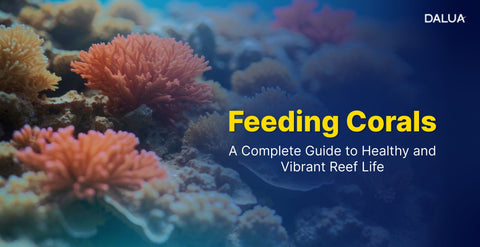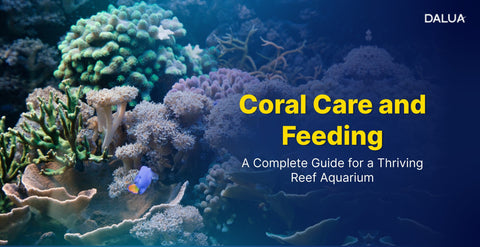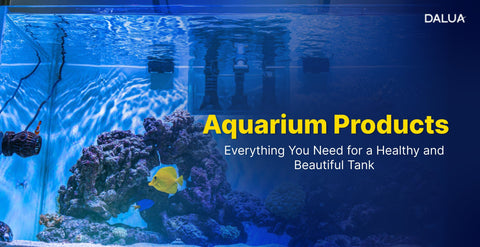Common Reef Tank Problems and How to Solve Them
So, you’ve set up your reef tank, invested in great equipment, added your favorite corals, and things still don’t look right. Sound familiar?
Don’t worry. Reef tanks are complex ecosystems, and even experienced hobbyists run into issues. The key is learning to recognize problems early and knowing how to fix them before they become serious.
In this blog, we’ll cover some of the most common reef tank problems and give you clear, actionable solutions. Whether it’s algae, cloudy water, or unhappy corals, this guide will help get your reef back on track.
1. Algae Overgrowth
What’s going wrong:
Algae blooms are one of the most common complaints among reef tank owners. It can appear as green hair algae, brown diatoms, or cyanobacteria (the red slime).
Why it happens:
● High nutrient levels (especially nitrate and phosphate)
● Inconsistent lighting schedules
● Overfeeding or lack of water changes
How to fix it:
● Test water regularly and maintain nutrient balance
● Reduce feeding and use protein skimmers to remove organics
● Schedule proper aquarium maintenance
● Consider using algae-eating clean-up crew (snails, hermits)
● Ensure good water flow using a wave maker
Tip: If you're using saltwater aquarium equipment, make sure it's properly calibrated, especially your skimmer and filters.
2. Cloudy or Murky Water
What’s going wrong:
You can’t enjoy your corals if your water looks like foggy soup.
Why it happens:
● Bacterial bloom
● Overfeeding
● Inadequate filtration or circulation
● Poor reef tank maintenance
How to fix it:
● Stop feeding for 24–48 hours
● Do a 20–30% water change
● Check and clean your mechanical filters
● Use activated carbon or a water clarifier
● Add a protein skimmer if you’re not already using one
3. Unstable Parameters (Alk, Calcium, Magnesium)
What’s going wrong:
Your corals aren’t growing, or worse, they’re bleaching or dying.
Why it happens:
● Inconsistent dosing
● Poor quality salt mix
● Lack of testing
How to fix it:
● Begin regular testing with reliable kits
● Use coral additives for dosing (Calcium, Alkalinity, Magnesium)
● Consider an automated dosing pump for stability
● Stick to a consistent water change schedule
Bonus: Our Coral Essentials Additives are trusted by reefers to maintain balanced levels with ease.
4. Corals Not Opening or Losing Color
What’s going wrong:
Corals look dull, closed up, or they’re not extending their polyps.
Why it happens:
● Poor lighting or incorrect light spectrum
● Low nutrient levels or trace element deficiency
● Improper flow
● Stress from water changes or nearby aggressive corals
How to fix it:
● Recheck your aquarium lighting setup (intensity and spectrum)
● Use amino acids or coral food as part of your feeding corals routine
● Dose trace elements like iodine, iron, and strontium
● Reposition corals and ensure proper water flow
5. High Temperature Fluctuations
What’s going wrong:
Corals seem fine during the day but shrink or look stressed at night, or vice versa.
Why it happens:
● No chiller or cooling fans
● Tank placed near a window or heater
● Inconsistent room temperature
How to fix it:
● Use a reliable heater and/or aquarium chiller
● Keep the tank in a temperature-stable environment
● Use a thermometer with alert system
● Keep your temp between 76 - 78°F (24–26°C) for most reef tanks
6. Low Water Flow or Dead Spots
What’s going wrong:
Detritus builds up in corners, corals seem unhappy, and algae grows in “dead” zones.
Why it happens:
● Inadequate circulation
● Poor positioning of powerheads or pumps
● Flow not reaching all parts of the tank
How to fix it:
● Add or reposition a wave maker or return pump
● Target flow toward problem areas
● Choose adjustable pumps to fine-tune your flow pattern
7. Fish or Inverts Dying Suddenly
What’s going wrong:
Your fish or clean-up crew suddenly disappear without explanation.
Why it happens:
● Ammonia or nitrite spike
● Copper contamination
● Aggression from other tank mates
● Rapid salinity or pH changes
How to fix it:
● Test water immediately for ammonia, nitrite, and copper
● Quarantine new additions
● Perform partial water changes
● Add activated carbon to absorb unknown toxins
● Make sure you're not overdosing any aquarium products
Final Thoughts
Maintaining a reef tank can feel overwhelming, but with the right knowledge and tools, it becomes way easier. Most problems stem from poor aquarium maintenance, lack of testing, or inadequate saltwater aquarium equipment.
If you stay consistent, follow a maintenance routine, and invest in the right gear, like protein skimmers, wave makers, lighting, and coral additives for dosing, your reef will reward you with vibrant growth and beauty.





